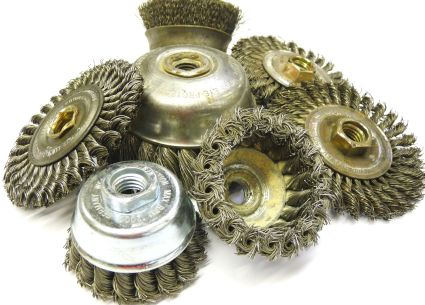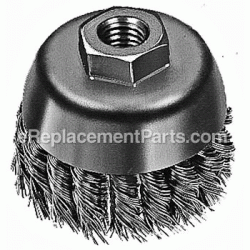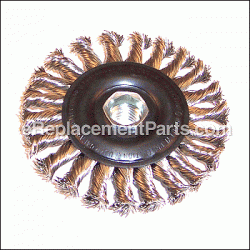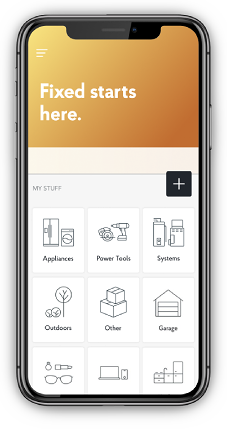Measurements Not surprisingly, some measurements factor in to a brush’s tool compatibility and work performance, the most important of which we've listed below:
diameter-
Most types of wire brushes have a diameter measurement which is important for matching tool compatibility, as well as knowing the maximum operating speed of a brush.
face width-
The width of a brush’s bristles (usually for wheels) is also a contributing indicator of brush aggressiveness. Wider brushes will be more aggressive, because of the increased abrasive surface area.
trim length-
For wire brushes, trim length alters brush performance in the same way that it does for polishing pads.
Longer trim (wire length) allows the fibers of the brush to lie down a little more than shorter trim brushes, making longer trim brushes less aggressive and better suited to adapt to contoured work pieces.
arbor size-
The arbor diameter helps match tool compatibility and is also factored in to the maximum diameter of a brush.
wire size (gauge)-
The lower the gauge, the thicker the wire in wire brushes, and thicker wires means more aggression. Wire brushes are typically manufactured with wires between the 20 and 47 gauge range.
Wire gauge is a major factor for matching a brush to its application, and follows these general guidelines:
Work Gauge
Heavy-duty/Coarse 20 – 24
Medium to Heavy 25 – 30
Medium 33 – 34
Light/Fine 35 – 38
Very Fine 43 – 47
MSFS (Maximum Safe Free Speed)-
Wire brushes--and especially wheels--have a maximum speed setting at which they can be use that is based on their diameter and other factors. This specification is called the brush’s Maximum Safe Free Speed (MSFS).
fill density-
This refers to how densely or not densely packed the bristles in a wire brush are. A higher fill density will mean more aggression, because of the presence of more abrasive fibers, and also because the fibers support each other better when placed closely together.
Lower density brushes will be less stiff, less abrasive, and are better suited for medium to fine brushing.
[Back to top]
Brush Style
If the shape can be imagined, there’s probably a wire brush to match it. The two most common wire brush styles are cup brushes and wheel brushes.
Cup Brushes Wheel Brushes
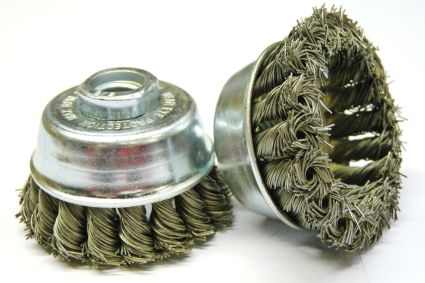
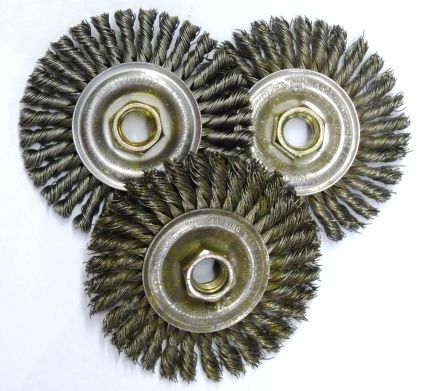 Despite the dozens and dozens of wire brush shapes, the abrasive properties they share in common work the same way. Usually, wire brush design differences adapt a brush to be able to reach its work in specialized ways.
[Back to top]
Despite the dozens and dozens of wire brush shapes, the abrasive properties they share in common work the same way. Usually, wire brush design differences adapt a brush to be able to reach its work in specialized ways.
[Back to top]
Wire Type
Wire type is the most determining factor for abrasion speed and aggressiveness.
Although qualities like wire gauge are also major contributors, a change in wire type will still drastically alter a brush’s performance, even between two otherwise similar brushes.
The two largest divisions in brush wire type are crimped wire and knot type wire brushes.
Crimped Wire Brushes
The crimping of crimped brush wires allows the bristles to better support each other than straight bristles.
Crimped wire brushes are less aggressive than knot type, and best for light to medium cleaning and material removal.
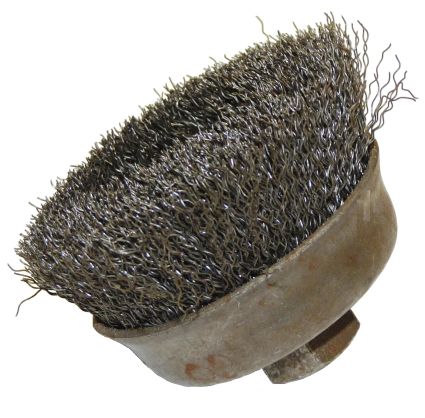 Two main factors create performance variations between crimped wire brushes: brush width and steel hardness. As discussed above, increased face width will produce more aggression.
For wire brushes, steel hardness is usually measured on the Rockwell scale, which measures the "indentation resistance" of materials.
Two main factors create performance variations between crimped wire brushes: brush width and steel hardness. As discussed above, increased face width will produce more aggression.
For wire brushes, steel hardness is usually measured on the Rockwell scale, which measures the "indentation resistance" of materials.
Rockwell hardness measurements are abbreviated “Rc,” followed by a hardness number. Most crimped wire brushes are manufactured with steel between Rc 30 and Rc 60. The higher the Rc measurement, the harder the steel.
Knot Type Brushes
The wires of knot type brushes are twisted to create greater resistance in the brush, suiting them for heavy duty work.
Knot type brushes are available in four major styles of manufacture that offer different levels of aggression:
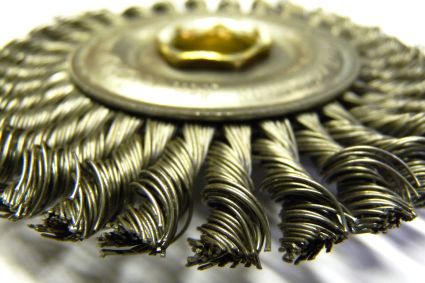
Standard Twist-
Standard twist brushes are more aggressive than crimped wire brushes, but they are the least abrasive of the knot type brushes.
Their twist style allows a small tuft at the end of the twist that provides some flexibility.
Stringer Bead Twist-
These are very tightly twisted all the way to the end of the knot (no tuft) to create even more brush resistance than standard twist brush styles.
The tight twist also creates a narrower knot face width.
The narrowness and aggression of these brushes makes them great for high impact weld cleaning in tight spots.
Cable Twist-
A wide, tightly twisted knot without a tuft for the highest level of aggression.
[Back to top]
Filament Materials
Wire brush abrasive filaments are also manufactured from different materials that affect their performance and application.
The most common filament materials are steel products, but non-steel metals and synthetic materials are also used for specialty applications.
carbon steel-
Carbon steel is the most common wire brush filament material. It is s a little harder than stainless steel, and therefore, more aggressive.
Milwaukee Carbon Steel Cup Brush
However, one of their drawbacks is their risk of creating “after rust,” where non-stainless steel is left behind to oxidize on the workpiece.
For some applications (like wood) this is often not a problem. Carbon steel brushes are also very durable.
stainless steel-
The pros and cons of stainless steel brushes are the reverse of carbon steel.
Bosch Stainless Steel Wheel Brush
Stainless steel does not risk leaving after rust, but these brushes are a little less durable and less aggressive than carbon steel brushes.
non-ferrous metals-
Some brush filaments are manufactured from metals other than steel, such as bronze, brass, and aluminum. These kinds of brushes are relatively uncommon, and are usually only used for specialty applications.
nylon-
Use of synthetic materials for brush fibers is a pretty recent development in the abrasive industry. Nylon is one synthetic brush material that is growing in popularity.
Nylon filaments are abrasive enough for light to medium brushing and cleaning applications, and they are especially valuable for their great durability.
[Back to top]
Conclusion
Search our Wire Brushes power tool accessories page to see our selection of cup and wheel wire brush abrasives.
With the information in this article as a guide, shoppers on eReplacementParts.com can match their abrasive wire brushes to their applications, and even narrow searches by the the compatibility measurements and design features discussed here.
Our website is comprehensive power tool and machine parts ordering and shipping service, including parts for outdoor equipment, engines, lawn and garden equipment, power tools, and their accessories.
Supporting dozens of industry leading manufacturing names, eReplacementParts.com is an all in one place warehouse of repair materials and information tools.
[Back to top]
What we're about.



















































